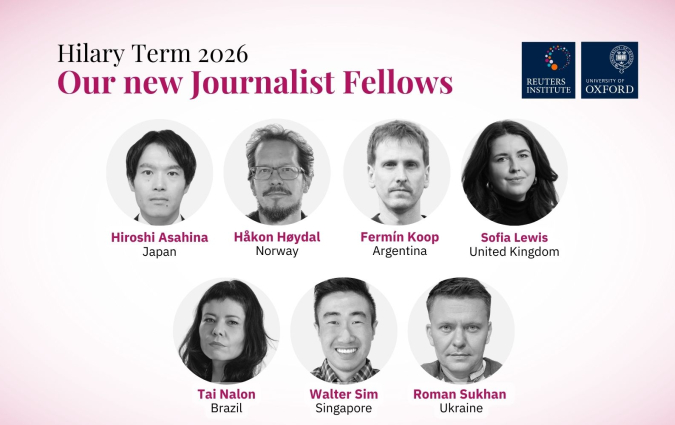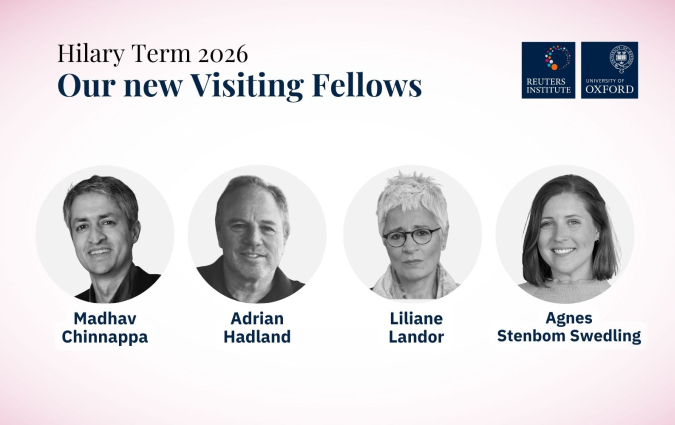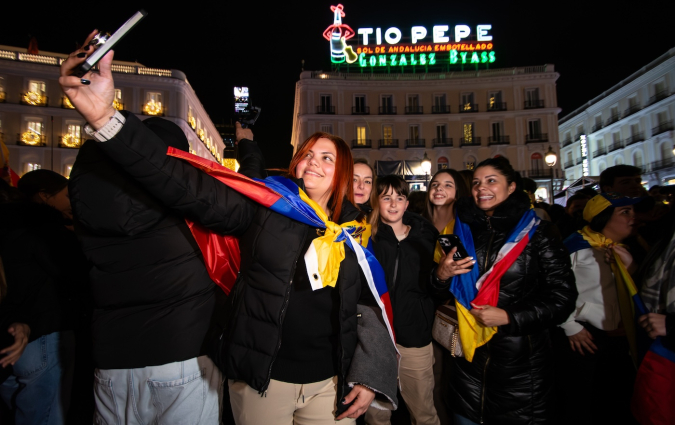Here are the ICA 2023 talks featuring researchers from the Reuters Institute

The 73rd annual conference of the International Communication Association takes place in Toronto, Canada, 25-29 May 2023. Here are the abstracts of the papers that will be shared by Reuters Institute researchers covering topics including trust in news, the impact of smartphone use, climate change news, misinformation and perceptions of fairness.
Trust in news falls as social media grows and television declines: Longitudinal data from 46 countries
Richard Fletcher, Simge Andı, Amy A. Ross Arguedas, Sumitra Badrinathan, Kirsten A. Eddy, Camila Mont'Alverne, Antonis Kalogeropoulos, Craig T. Robertson, Anne Schulz, Benjamin Toff and Rasmus Kleis Nielsen
Changes to levels of public trust in the news are of deep concern to both researchers and practitioners. We use annual data from 2015 to 2022 in 46 countries to explore how trust in news has changed, differences by media system, and the effect of changing patterns of news use. Using random effects within-between (REWB) modelling, we find that (i) there has been a small overall decline in trust in news since 2015, but that (ii) there are very different patterns in different countries. While there is (iii) some limited evidence of differences by media system, with hybrid and polarized pluralist countries seeing steeper declines, (iv) differences are much better explained by changes in news media use. More specifically, within-country declines in television news use over time—and parallel increases in social media news use—are significantly associated with declines in trust. The results do not support the idea of a global decline in trust in news in recent years, but do suggest that this is a possibility if people move away from broadcast television in the long term.
Political communication > High density: news avoidance, trust, selective exposure, and curation
Platform power in the shadow of the state
Rasmus Kleis Nielsen and Sarah Anne Ganter
Platform companies exercise different kinds of power in society, including platform power, which involves the ability to set standards, make and break connections, automate action at scale, a high degree of opacity, and operate across domains. As one of the most successful platform companies, Google illustrates this even more than its various competitors. In this presentation, we discuss how platform power is exercised in the shadow of the state, whether the latter takes active measures, or engages in deliberate non-intervention or “negative policy”. We do this on the basis of a comparative case study of relations between news publishers and Google across France, Germany, the UK, and the US from 2009 to 2012, identifying clear examples of active exercise of political power (in France), public debate but deliberate non-intervention (in Germany and the US), and relative lack of debate and negative policy (in the UK).
Journalism studies > A new agenda-setting? Google’s impact on global journalism policy and infrastructures
Shortcuts to trust: A bottom-up approach to how people use heuristics to judge online news in the platform era
Amy Ross Arguedas, Sumitra Badrinathan, Camila Mont'Alverne, Benjamin Toff, Richard Fletcher and Rasmus Kleis Nielsen
Scholarship has increasingly sought solutions for reversing broad declines in levels of trust in news in many countries. Some have advocated for news organizations to adopt strategies around transparency or audience engagement, but there is limited evidence about whether such strategies are effective, especially in the context of news consumption on digital platforms where audiences may be particularly likely to encounter news from sources previously unknown to them. In this paper, we use a bottom-up approach to understand how people evaluate the trustworthiness of online news. We inductively analyze in-depth interviews and focus groups with 232 people in four countries (Brazil, India, the United Kingdom, and the United States) to understand how they judge the trustworthiness of news, especially when unfamiliar with the source. Drawing on prior credibility research, we identify three general categories of cues that are central to heuristic evaluations of news trustworthiness online: content, social, and platform cues. These cues varied only minimally across countries, although larger differences were observed depending on the platform. We discuss the implications of these findings for scholarship and trust-building efforts.
Journalism studies > Perceptions of news: notions of trust and fairness
Do smartphones make us sad? It depends how you measure it, evidence from Pakistan based on logged data
Waqas Ejaz, Sacha Altay, Ghazala Naeem
Fears about the impact of smartphone use on well-being abound, and there is an ongoing debate about how to measure media use. Yet, most research on these topics comes from the Global North. In a pre-registered survey conducted among 427 Pakistani citizens, we estimate the accuracy of self-reported smartphone use compared to actual smartphone use (as measured by screen time apps) and investigate how smartphone use relate to well-being. We find that participants underreported daily smartphone use by 11 minutes (r = .37). Actual smartphone use was negatively associated with well-being while self-reported smartphone use was not. Yet, self-reported smartphone use was positively associated with well-being among participants with high fear-of-missing-out (FoMO) and negatively associated with well-being among participants with low FoMo. These findings invite more optimism about self-reported measures of smartphone use and highlight the benefits of combining self-report data with logged data. We show that mobile data donations in countries like Pakistan is viable, and that before drawing firm conclusions regarding the effects of smartphone use, more research is needed in the Global South.
Mobile communication > Digital wellbeing and emotions
Visual representations of climate change: A meta-analysis
Waqas Ejaz, Muhammad Ittefaq, Rabia Quisen
Past research informs us that mainstream news media often uses visuals that misrepresent climate change. Thus, in line with the importance of visuals, the last two decades have seen flurry of studies investigating the use of images by news media to communicate climate change. Consequently, the scholarship over time has offered a range of different findings. For example, research informs us that the increased frequency of heatwaves increased its coverage (O’Neill et al., 2022), but rather than using the image that illustrates the perils of heatwaves, it is often presented as an enjoyable activity. Furthermore, studies have linked extensive use of contested and distancing visual frames with the rise of climate change scepticism in mid-2000s (O'Neill, 2020). In addition to contested imagery, fear-inducing visuals regarding climate change are widely employed in the public domain but remain an ineffective tool for motivating personal engagement with the issue (Leviston et al., 2014; O'Neil & Nicholson-Cole, 2009). Therefore, this present study provides first systematic and comprehensive overview of the objects and characteristics of communication research field through a meta-analysis. It identifies 69 relevant studies obtained through the main dataset for the field of communication, i.e., Communication & Mass Media Complete. The preliminary results show lack of comparative studies and overwhelming focus on the Global North countries. Furthermore, the manual content analysis has remained the most preferred methodology to analyse climate change-related visual. Additionally, most studies focus on examining the images published in print news media. We discuss the implications of these findings for effective public engagement and journalists.
Environment communication > HIGH-DENSITY: visual environmental communication: visualizing climate change and environmental threats
Is digital platform use related to exposure to criticism about journalism and reduced trust in news?
Camila Mont'Alverne, Amy A. Ross Arguedas, Sayan Banerjee, Benjamin Toff, Richard Fletcher and Rasmus Kleis Nielsen
Recent academic literature and practitioners indicate the role of digital platforms in spreading criticism towards journalists, and potentially eroding trust in news. We use an original survey in Brazil, India, UK, and US to investigate if those who use platforms are more likely to see criticism about journalism. Our results indicate that using certain platforms and consuming online news is positively related to self-reported exposure to criticism, but political interest is a more consistent predictor. We also find that people who are more exposed to media criticism tend to have lower levels of trust in news in general, except in India.
Overcoming distrust in the news media by reclaiming authenticity
Does news use and trust in news keep people from believing in misinformation? An examination of the 2022 Brazilian elections
Camila Mont'Alverne, Amy A. Ross Arguedas, Sayan Banerjee, Benjamin Toff, Richard Fletcher and Rasmus Kleis Nielsen
Electoral misinformation, where citizens believe false or misleading claims about the electoral process and electoral institutions – sometimes actively and strategically spread by political actors – is a challenge to public confidence in elections specifically and democracy more broadly. In this article, we analyze a combination of 42 million clicks in links and apps from behavioral tracking data of 2,200 internet users and a four-wave panel survey to investigate how different kinds of online news and media use relates to beliefs in electoral misinformation during a contentious political period—the 2022 Brazilian presidential elections – and examine trust in news as a moderating factor. We find that, controlling for other factors, using news from legacy news media is associated with belief in fewer claims of electoral misinformation over time, whereas we find null or inconsistent effects for using, respectively, digital born news media and various digital platforms including Facebook and WhatsApp. Furthermore, we find that trust in news play a significant role as a moderator, even as belief in electoral misinformation also, in turn, undermine trust in news. Overall, our findings document the important role of the news media as an institution in containing electoral misinformation, even as they also underline the precarity of trust in news during contentious political periods.
Political communication > HIGH DENSITY: knowledge, understanding, misinformation, and ambiguity
(Not) talking politics: Navigating contentious political conversation and disagreement in four countries
Kirsten A. Eddy, Camila Mont'Alverne, Benjamin Toff
In this study, we build upon prior work examining how political talk has weathered stresses facing civic culture (Wells et al., 2017). Drawing from comparative analyses of 2022 survey data across four countries with different sociocultural, political, and media environments and varying levels of political polarization – India, Brazil, the US, and the UK – we examine people’s frequency of political talk, (dis)comfort talking about politics, and the closing of conversations due to political disagreement both in general and on specific social platforms, including Facebook and WhatsApp. We plan to draw from descriptive data and to examine predictors of these behaviors as well as the differences in contentious political talk online versus offline using regression analysis. In doing so, we offer theoretical and empirical advancements in our understandings of contentious political conversation and disagreement as well as novel comparative findings in this area across four countries.
Political communication > Political deliberation and expression
Exploring perceptions of fairness in news coverage across 45 Countries
Kirsten A. Eddy, Richard Fletcher
Over the past several years, social and political movements in many countries around the world have turned public and academic attention toward the fairness of news coverage with respect to gender, age, racial and ethnic, socioeconomic, and political identities—as well as the knock-on effects of the (un)fairness on political attitudes and participation, and on how fairness (or lack of) might be shaped by newsroom diversity. This study examines how global audiences think about how the news media cover people like them. We use online survey data in 46 markets from the Reuters Institute’s 2021 Digital News Report (N=92,372) to investigate public perceptions of fairness in news coverage of people’s own (i) age, (ii) gender, and (iii) political views. We estimate separate linear regression models for each country, controlling for a series of individual-level sociodemographic, news use, and news attitude variables. Results reveal several fault lines in public attitudes toward news coverage: We find associations between respondents’ political views, gender, and age, and their perceptions of fair news coverage. We also show how one or more of these patterns persist across a diverse range of geographic regions and political and media systems.
Journalism studies > Perceptions of news: notions of trust and fairness







